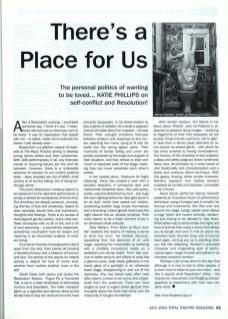After a Resolution evening, I overheard someone say, 'I think it's sad. I mean, these dancers just so obviously want to be loved.’ It was an observation that stayed with me – or rather, made me re-evaluate the pieces I had already seen...
Resolution is a platform season of triple-bills at The Place Theatre aiming to develop young dance artists and their companies. With 108 performances in all, any thematic trends or recurring issues are few and far between. However, there is a noticeable absence of reaction to our current political state – fears revealed are not of WMD, child poverty or of bombs falling, but of being terrifyingly alone.
This year's Resolution certainly seems to be testament to the idea that performance is simply a vehicle for acceptance of some kind. The storylines are deeply personal, converging themes of love and loneliness, based on diary excerpts, secret lives and subversion, thoughts and feelings. There is an excess of stereotypical gender politics, some clear aesthetic structures with no fill or frill, and a lot of soul searching – a sometimes desperate, sometimes nonchalant hunt for reason and meaning in an introverted analysis of modern living
Four dance-theatre choreographers stand apart from the rest, their pieces all housing a visceral intimacy and a balance of humour and fear. The stories of the pieces do indeed portray a search for love of some kind, whether from mother, brother, lover or the self.
Sarah Fahie both opens and closes the Resolution Season. Fugue For a Furnished Flat is set in a stark landscape of alternating humour and desolation. The male character lights up a cigarette and dances alone as the female tries to kiss him and lure him into more romantic escapades. In his determination to play a game of solitaire, he is dealt a poignant card as she talks about her husband – his best friend. Their wrought emotions fluctuate between isolation and closeness as she hovers, watching him move, trying to fit into his world like the wrong jigsaw piece. Their moments of tender falling and union are quickly subverted by the angst and anguish of their situation, and they retreat to their own music on separate sides of the stage, realising they can never penetrate each other's worlds.
In her newest piece, Nocturne for Night Cleaning, Fahie has created a work with a similarly beautiful, if somewhat dark and melancholic theatrical vision. She uses quirky, subtle, odd and distracted humour – she hugs the neon lighting before her face gets stuck in an air duct, which later spews out rubbish; screeching dustbin bags empty themselves and a knocking, rubber-gloved hand lures the night cleaner into an allusive romance. Their union seems to be a freak moment of joy in an otherwise bleak solitude.
Sally Marie's From Mum to Mum from Me explores the realms of making a dance to show her mum 'her bestest dancing’, squeaking from the darkness of an unlit stage, exposing her vulnerability by teetering with a childlike conceptual reality on a pedestal-cum-diving board. From bad posture to ballet posture and efforts to pose like a glamour-puss, Sally Marie gallivants in the harsh glare of a spotlight in an otherwise black stage, disappearing in and out of the darkness. She has baked cake after cake after cake in a show to win some kind of gratitude from the audience. There are more laughs at such a sugary sweet gesture than thoughts about the fears that come with the insecurity of bought friendships.
With similar candour, Tim Morris in his debut piece Portrait uses his Polaroid in an attempt to preserve dying images – clutching at fragments of time that disappear all too quickly. Props include iced buns, left to gather dust from a dinner party attended by no one except his potted plants – with whom he has since reverted to having conversations. The humour of this character is fast eclipsed; a deep and deftly poignant forlorn loneliness takes over, all portrayed by a cross breed of vital theatricality and characterisation and a sharp and vivacious dance technique. With this gawky, limping, rather simple character, Morris' exposure and waiting remains unsolved as he falls and trembles, vulnerable in his Y-fronts.
Aerial dance performer Wendy Hesketh presents an innovative fusion of performance technique: using a bungee rope to amplify her themes and movements. She flies over and around the stage, hangs upside down above a huge ‘toilet' and hovers vertically, screaming and kicking to be allowed to stay there. What better way to demonstrate the highs and lows of bulimia than using a device that allows you to dangle and lurch in mid-air above the porcelain bowl, flounder away only to bounce back again, and tug you up to standing when you feel like collapsing. Hesketh's animated character and invigorating style of performance again merge comedy and pathos in an intensely personal creation.
Perhaps it all comes down to the fact that although it is nice to talk to other people, it is even nicer to listen to your own voice – and this is exactly what Resolution offers – the chance for newcomers and fledgling choreographers to experiment with their own creative voice.

